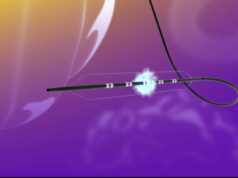Following three recent studies (RESILIENT, ABSOLUTE and REAL SFA) that concluded that stenting in the superficial femoral artery (SFA) resulted in ‘acceptable’ results when compared with other treatment options, the body of evidence for using either stents or covered stents in the superficial femoral and femoropopliteal arteries is building.
However, despite such results questions and doubts still remain about the long-term durability of nitinol stents in the SFA. In a recent presentation, Dr Giancarlo Biamino, University of Leipzig Heart Center, Germany, discussed the significance of fractures in nitinol stents, their causes and what design improvements can be made.
He began by citing the case study of Scheinert et al (Journal American College of Cardiology, 18 January 2005) that reported the results X-ray screening at 10.7 months follow-up. The study found fractures in 45 of 121 treated legs (37.2%) and in 64 of 261 implanted stents (24.5%).
Biamino defined three different fracture classifications. Minor fractures (single strut fracture), which were present in 31 cases (48.4%), moderate fractures (fracture of >1 strut), which were found in 17 cases (26.6%), and severe fractures (separation of segments) in 16 cases (25.0%). Moreover, Biamino discussed the relationship between the prevalence of stent fractures and length of the stented segments. Stent fractures were located in 13.2% of stents with <8cm segment length, compared with 42.4% of stents with a >8 <16 cm segment length and 52.0% of stents with >16cm (three or more stents).
According to Biamino, the level of dependent stress is related to the distribution of stent fractures along the SFA, which the findings from the Scheinert et al study confirmed. The clinical impact of the stent fractures resulted in restenosis >50% at 32 fracture sites (32.8%), stent occlusion at 22 fracture sites (34.4%), with no re-obstruction at 21 fracture sites (32.8%).
According to Biamino, there are a number of mechanical factors that contribute to stent fractures, surface defects and microcracks. In addition, he mentioned the role of axial stiffness that allows a stent to maintain its shape and contour while at rest. However, placing a stent into the artery can alter the axial stiffness adding stress, which could contribute to stent kinking or fracturing.
Biamino said that current SFA trials with the Smart stent (Cordis), such as the DURAVEST-Trial (the Netherlands), the SUPER trial (UK) and the SUPER-SL trial (Germany), as well as the RESILIENT trial, which is using the Edwards LifeStent NT, could reveal more about the causes of stent fractures. Biamino said that before thinking about drug-eluting stents in the SFA, “changes in the mechanical performance of the nitinol stents are mandatory”.
Biodegradable stents
Therefore, Biamino asked the question – if nitinol stents are not right, are biodegradable stents the answer? As well as stent fractures, metallic stents also induce varying degrees of thrombogenesis and significant hyperplasia, with restenosis rates of 25-40%. Furthermore, the long-term effects of metallic stents in human arteries are still unknown. These stents remaining in place may be obstacles to additional treatments
However, as restenosis commonly occurs within 3-6 months after endovascular interventions clinical need for stent scaffolding there is
limited after this period. Therefore, Biamino argued, stents made of absorbable, very flexible materials may be an ideal alternative as well as providing a useful delivery mechanism for the local administration of pharmacological agents.
Biamino then made an assessment of the Igaki-Tamai Biodegradable Peripheral Stent. The system was evaluated in the Perseus study, to analyze the feasibility and safety of a new biodegradable polymer poly-llactid (PLLA) stent in patients with suitable SFA lesions. The study was a prospective, non-randomized, single center, pilot study that recruited 45 patients with de novo lesions of the SFA (Type B and C). A maximum of two stents were permitted, limiting the length of the lesion to 6cm
Results from the study showed a primary success rate 100% with no serious adverse events. The six month angiographic results revealed no re-occlusions although there were nine symptomatic restenoses that were all successfully retreated and asymptomatic angiographic restenosis (<50%) in three cases (6.6%). Overall, Biamino said that the Igaki-Tamai stent is safe and its use in the SFA feasible and the very encouraging results at three months indicate that the initial radial force is sufficient. He indicated that the later restenosis process may be related to an inflammatory reaction during the bio-absorption of the stent. “Despite these encouraging outcomes, the results must be validated in larger trials including more complex lesions. PLLA-stents at the moment are not the final solution – there is still a long way to go,” he concluded. Dr Ron Waksman, Professor of Medicine, Washington Hospital Center, Washington DC, also advocated the use of absorbable metal stents in the coronary artery. He began by stating that absorbable stents fit the with criteria the ideal of temporary vessel scaffolding. Furthermore, he said that the need for coronary stents is limited after 6-9 months, when their job are completed. Therefore, the materials implanted should be eliminated as promptly as possible to minimize the possible side effects. He said the bottom line was, why choose a permanent prosthesis to solve a temporary healing problem? Waksman discussed the Reva Bioresorbable Stent a fully bioresorbable coronary stent system, which are an integral drug-elution coating (paclitaxel). The polymer is combined with slide-and-lock technology, a stent design that allows deployment without significant deformation of the stent structure. This is a major advantage as polymers are not as resistant to deformation as metals. In-vivo studies have demonstrated that stents with the slide-and-lock design can be successfully deployed in femoral and coronary porcine arteries using standard balloon. Another program mentioned by Waksman was the Guidant bioabsorbable vascular stent (BVS). Finally, he discussed Biotronik’s absorbable metal stent (AMS). The device consists of an alloy with more than 90% magnesium in combination with different rare earth elements. The stent is completely absorbed by the surrounding vessel wall. It is believed that this yields low rates of thrombogenic events and supports a homogenous degradation process of the stent without any risk of particle migration and subsequent micro-embolism. He mentioned Biotronik’s AMS-INSIGHT 1 Study (Absorbable Metal Stent Investigation in Chronic Limb Ischemia Treatment), a prospective, multi-center, randomized clinical trial aimed at assessing the safety and performance of the AMS for the treatment of infrapopliteal lesions in patients with chronic limb ischemia. Patients treated with AMS will be compared to results of a patient group treated with percutaneous angioplasty alone. In total 115 patients are planned for recruitment amongst the 11 European centers involved in this study. The study plans a follow up at one, six and 12 months.













